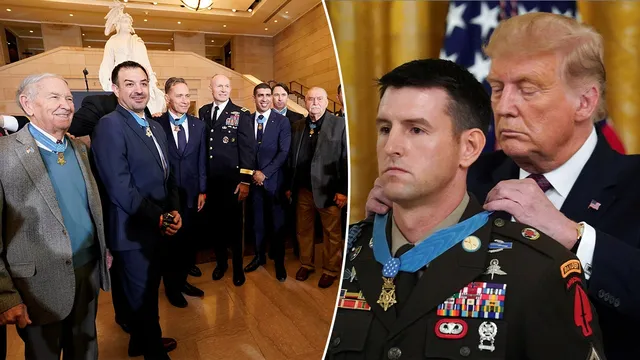
William Swenson honors fallen comrades with Medal of Honor dedication
2025-04-07 20:25- William Swenson received the Medal of Honor for his actions during a battle in Afghanistan on September 8, 2009.
- He credits his fellow soldiers and their sacrifices while emphasizing that the award represents collective valor.
- Swenson hopes the National Medal of Honor Museum will inspire future generations to serve their communities.
Express your sentiment!
Insights
In September 2009, in eastern Afghanistan, retired Army Captain William Swenson demonstrated extraordinary bravery during a fierce engagement with insurgents. On that day, Swenson faced enemy fire from 60 insurgents to rescue and aid his fellow soldiers, showcasing exemplary courage and commitment to his mission. His selfless actions that day led to him receiving the Medal of Honor, the nation's highest military award, recognizing not only his heroism but also the sacrifices of his comrades. During an interview on Fox News, Swenson underscored that the award does not solely represent his achievements but reflects the collective valor and sacrifices of all soldiers who fought alongside him. Recently, Swenson celebrated the opening of the National Medal of Honor Museum in Arlington, Texas, which pays tribute to all Medal of Honor recipients. He emphasized that the museum serves not just as a collection of historical facts, but as a living institution of valor that honors the stories and sacrifices of service members. In his view, the museum will evolve over time and will provide inspiration for future generations to serve their communities. Swenson hopes that visitors will recognize the reflections of courage and dedication mirrored in the stories of Medal of Honor recipients, motivating everyday citizens to emulate such heroism in their lives. Swenson's dedication to his fellow soldiers, especially those who did not return from the battlefield, was a poignant aspect of his remarks. He acknowledged that while the medal bears his name, its significance lies in the fallen heroes and the bonds forged in combat. The award he received represents a promise to honor their memory and legacy by advocating for the values they fought to protect. Swenson reaffirmed that it is the actions of soldiers, sailors, airmen, Marines, and Afghan partners that truly warrant recognition. As he looks toward the future, Swenson is hopeful that the museum will inspire a deeper appreciation for the sacrifices made by military personnel. The desire is that it will motivate citizens to acknowledge and fulfill their responsibilities to their communities, reflecting the dedication and service demonstrated by those who received the Medal of Honor. By sharing these stories of bravery, Swenson believes that they can instill a sense of duty and service in the hearts of all Americans.
Contexts
The Medal of Honor, the United States' highest military decoration, has a storied history rooted in recognition of extraordinary acts of valor. Established during the Civil War on December 21, 1861, it was initially meant to honor Union soldiers for exceptional bravery in battle. The inception of this prestigious award was driven by the need to acknowledge acts of gallantry that went beyond the call of duty amid the tumultuous conflicts of war. The first medals were awarded to 200 soldiers in March 1863, paving the way for a tradition that would evolve over the decades to recognize individuals across all branches of the U.S. military, including the Army, Navy, Air Force, Marine Corps, and Coast Guard. As the Medal of Honor gained prominence, its criteria and presentation transformed substantially. Originally, it was designed to be accessible to enlisted personnel, which was revolutionary for the time. The medal itself features a unique design; it is shaped like a star and suspended from a blue ribbon. Each branch of the military has its own unique design reflecting their service, yet they all share a universal respect for the extraordinary courage exhibited by those who receive it. By the end of the 19th century, the Medal of Honor became a symbol of national pride, and its recipients, often celebrated as heroes, were honored in various public ceremonies and events. Throughout the 20th century, the Medal of Honor became increasingly selective in its awarding process, in part due to the Vietnam War and subsequent conflicts which showcased the harsh realities of combat. The inconsistent standards of previous decades prompted a review of the processes involved in recognizing worthy actions. Notably, 83 medals were awarded for bravery during the Vietnam War, a period that saw significant changes in both public perception of the military and the criteria for earning the Medal. The Vietnam era also triggered an interest in reviewing past recipients, leading to evaluations and, in some cases, the posthumous awarding of medals to more than 30 individuals who had been overlooked due to racial or other biases. In contemporary times, the Medal of Honor continues to serve as a vital emblem of bravery and sacrifice. Its significance endures not only as an acknowledgment of individual heroism but also as a representation of the values and ideals of the nation. Awareness and reverence for the medal have been bolstered through numerous memorials, educational efforts, and dedicated programs designed to honor recipients, such as the annual Medal of Honor Day. The ongoing efforts to review and recognize deserving individuals ensure that the legacy of the Medal of Honor remains relevant and respected, embodying the courage and sacrifice of those who have fought valiantly for their country.